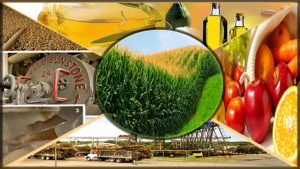 To convey an idea of the textural make up of soils and to give an indication of their physical properties, soil textural class names are used. These are grouped into three main fractions viz., Sand, Silt and Clay.
To convey an idea of the textural make up of soils and to give an indication of their physical properties, soil textural class names are used. These are grouped into three main fractions viz., Sand, Silt and Clay.
According to the proportion of these three fractions a soil is given a name to indicate its textural composition. Such a name gives an idea not only of the textural composition of a soil but also of its various properties in general.
On this basis soils are classified into various textural classes like sands clays, silts, loams etc
Sands: The sand group includes all soils in which the sand separates make up at least 70% and the clay separate 15% or less of the material by weight. The properties of such soils are therefore characteristically those of sand in contrast to the stickier nature of clays. Two specific textural classes are recognized in this group sandy and loamy sand although in practice two subclasses are also used Loamy fine sand and loamy very fine sand.
Silt: The silt group includes soils with at least 80% silt and 12% or less clay. Naturally the properties of this group are dominated by those of silt. Only one textural class – Silt is included in this group.
Clays: To be designated clay a soi1 must contain at least 35% of the clay separate and in most cases not less than 40%. In such soils the characteristics of the clay separates are distinctly dominant, and the class names are clay, sandy clay and silty clay. Sandy clays may contain more sand than clay. Likewise, the silt content of silty clays usually exceeds clay fraction.
Loams: The loam group, which contains many subdivisions, is a more complicated soil textural class. An ideal loam may be defined as a mixture of sand, silt and day particles that exhibits the properties of those separates in about equal proportions. Loam soils do not exhibit dominant physical properties of sand, silt or clay. Loam does not contain equal percentage of sand, silt and clay. However, exhibit approximately equal properties of sand, silt and clay.
Determination of Textural Class: In the American system as developed by the United State Department of Agriculture twelve textural classes are proposed.
The textural triangle: It is used to determine the soil textural name after the percentages of sand, silt, and clay are determined from a laboratory analysis. Since the soil’s textural classification includes only mineral particles and those of less than 2mm diameter, the sand plus silt plus clay percentages equal 100 percent. (Note that organic matter is not included.) Knowing the amount of any two fractions automatically fixes the percentage of the third one.
To use the diagram, locate the percentage of clay first and project inward parallel to sand line. Do likewise for the per cent silt and project inward parallel to clay line and for sand, project inward parallel to silt. The point at which the projections cross or intersect will identify the class name.
Some times, the intersecting point exactly falls on the line between the textural classes. Then it is customary to use the name of the finer fraction when it happens. (e.g). Soil containing 40% clay, 30% sand and 30% silt – called as clay rather than clay loam.
Importance of Soil Texture
Presence of each type of soil particles makes its contribution to the nature and properties of soil as a whole
Texture has good effect on management and productivity of soil. Sandy soils are of open character usually loose and friable.
Such type of the texture is easy to handle in tillage operations.
Sand facilitates drainage and aeration. It allows rapid evaporation and percolation.
Sandy soils have very little water holding capacity. Such soils can not stand drought and unsuitable for dry farming.
Sandy soils are poor store house of plant nutrients
Contain low organic matter
Leaching of applied nutrients is very high.
In sandy soil, few crops can be grown such as potato, groundnut and cucumbers.
Clay particles play a very important role in soil fertility.
Clayey soils are difficult to till and require much skill in handling. When moist clayey soils are exceedingly sticky and when dry, become very hard and difficult to break.
They have fine pores, and are poor in drainage and aeration.
They have a high water holding capacity and poor percolation, which usually results in water logging.
They are generally very fertile soils, in respect of plant nutrient content. Rice, jute, sugarcane can be grown very successfully in these soils.
Loam and Silt loam soils are highly desirable for cultivation
Generally, the best agriculture soils are those contain 10 – 20 per cent clay, 5 – 10 per cent organic matter and the rest equally shared by silt and sand
Original article here







